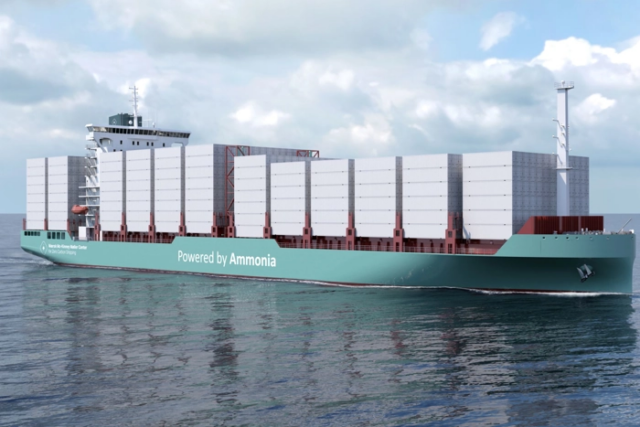Lloyd’s Register: vessel AiP and development updates
By Julian Atchison on June 12, 2024
Busy week in Posidonia

Click to learn more. Graphic visualisation of LR and Guangzhou Shipyard International’s initial VLAC design. Source: Lloyd’s Register.
Multiple AiP awards for ammonia-fueled vessels have emerged from the annual international shipping exhibition in Greece. Dominating the announcements was UK-based class society Lloyd’s Register (LR), which granted AiPs to ammonia-centric vessel designs from China, Denmark, and South Korea.
World’s largest VLAC
LR and Guangzhou Shipyard International will jointly develop a design for the world’s largest VLAC (Very Large Ammonia Carrier), with a carrying capacity of 100,000 m3. The onboard storage tanks will meet all requirements for the IMO Type B standard.
The 100,000 cbm VLAC design was developed with input from of our long-term partners and an ammonia producer. Thanks to the trust extended by all parties, especially the support from LR, GSI has developed the largest VLAC design in the world.
Chen Ji, Chairman of GSI in LR’s official press release, 4 June 2024
Container vessel

Click to learn more. Graphic visualisation of a 3,500 TEU, ammonia-fueled container vessel design led by the Maersk Mc-Kinney Møller Center for Zero Carbon Shipping. Source: Lloyd’s Register.
AiP was also awarded in Posidonia for a newly developed ammonia-fuelled 3,500 TEU container vessel. The design consortium includes Maersk, MAN Energy Solutions, Deltamarin, LR and ABS, led by the Maersk Mc-Kinney Møller Center for Zero Carbon Shipping.
The fact that we have both ABS and LR granting this AiP in parallel is a testimony to the robustness of the design and to the iterative risk assessment and systematic risk management intelligence that have gone into it. This development work has only been possible because all project partners have contributed with innovative thinking and willingness to share knowledge. Collaboration is the fastest way to co-creating the prescriptive rules and innovative solutions we need.
Claus Graugaard, Chief Technology Officer, Onboard Vessel Solutions at the Maersk Mc-Kinney Møller Center for Zero Carbon Shipping in LR’s official press release, 3 June 2024
Based on Amogy’s ammonia-to-power technology
Posidonia featured several vessel AiPs featuring Amogy’s technology. LR awarded AiP to HD Hyundai Mipo Dockyard and Korea Shipbuilding and Offshore Engineering for its fuel-cell propelled, 1,300 TEU feeder ship design, equipped with Amogy’s ammonia-to-power technology. The vessel design incorporates Amogy’s technology for both main and auxiliary propulsion, equating to a power output around 8000 kW. LR also awarded AiP to Samsung Heavy Industries and Amogy for an 88,000 m3 capacity, fuel cell-powered ammonia carrier.
Meanwhile, the American Bureau of Shipping and the Liberian Registry both granted AiP to HD Hyundai Heavy Industries and Capital Gas for a very large ammonia carrier (VLAC) design. The 93,000 m3 capacity carrier will integrate Amogy’s technology into its auxiliary power systems, with an output around 1400 kW.
NOX compliant container vessel
AiP was awarded to the Chinese design company SDARI for its ammonia-propelled 8,200 TEU container vessel design. SDARI worked in partnership with Mediterranean Shipping Company and MAN ES on the design, which features a 73,000 m3 Type C ammonia tank, and a MAN 6G80-C10.5 -LGIA ammonia-fueled engine. This engine will be coupled with a high-pressure selective catalytic reduction system to make vessel emissions compliant with IMO NOX regulations.
Very Large Ore Carrier, world’s largest car carrier
AiP was awarded to the Marine Design & Research Institute of China (MARIC) for a 360,000 DWT ammonia-fuelled Very Large Ore Carrier (VLOC) design. The large capacity, ocean-going design will be capable of loading iron ore and bauxite to “full load”, and suitable for running on Brazil and West Africa routes. Two Type C ammonia fuel tanks will be located in the wing tanks of the cargo hold area, with the fuel preparation room on deck in the same area. These will be well-distanced from accommodation areas, offering better segregation between the crew and gaseous fuel leaks.
MARIC also received AiP from LR at Posidonia for a dual-fuel, 12,800 CEU capacity pure car and truck carrier (PCTC) design – the world’s largest car carrier to date.
H2SITE’s onboard cracking technology

Click to learn more. H2SITE’s containerised, onboard ammonia cracking technology deployed on the Bertha B vessel for operational tests. Source: H2SITE.
Not signed at the Posidonia event but hugely relevant to our readers, LR recently awarded AiP to H2SITE for its onboard ammonia cracking technology. H2SITE’s containerised system can produce fuel-cell-quality hydrogen using ammonia, which can then be fed to fuel cells that propel the vessel (or consumed in a hydrogen capable engine). H2SITE operationally demonstrated the system last November onboard Zumaia Offshore’s Bertha B vessel, which sailed in the Gulf of Biscay. H2SITE intends its system to be integrated with both propulsion systems and auxiliary power units in a range of vessels, from offshore platforms to tankers and gas carriers.
After completing full technical validation at the kW scale under the H2Ocean and APOLO project, new developments will scale up H2SITE’s membrane reactors to the MW scale.
Jose Medrano, Technical Director at H2SITE in LR’s official press release, 28 Apr 2024